Songkran – Thai New Year
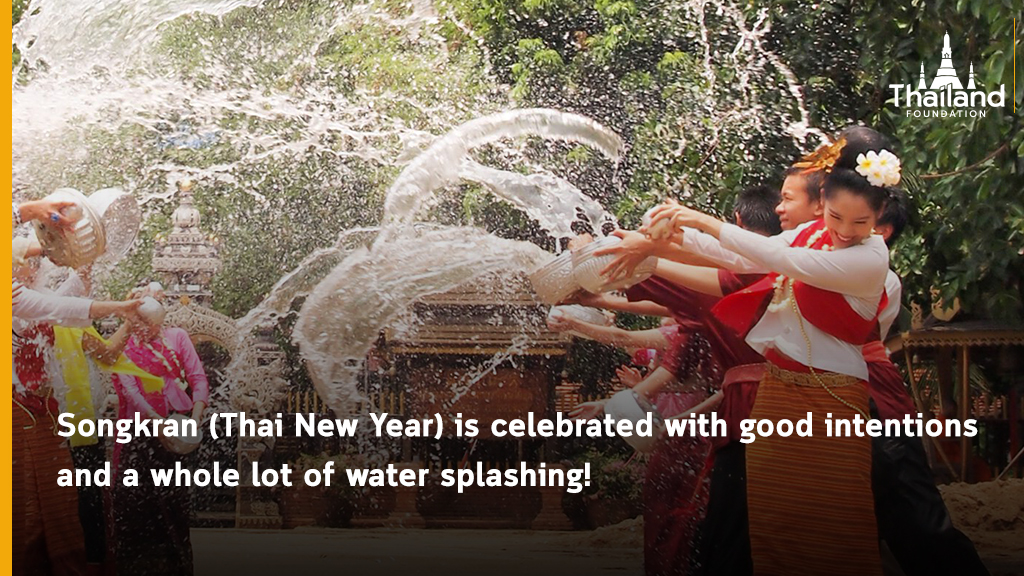
What is Songkran?
On a global scale, New Year is celebrated on the first of January, but the cultural diversity on this planet permits us to enjoy more than one New Year’s Day. In April, while Christian communities around the world are preparing to hunt Easter’s eggs, in Thailand, we can hardly wait until April 13 to throw or splash water on one another during our traditional holiday known as Songkran or Thai New Year.
In terms of tourism, it is often referred to as the “Thai Water Festival.” The jolly spirit of summer is boosted with cooling powder and water guns, walking streets filled with happy people in soaking wet clothes, stereo sets blasting danceable beats, laughter, and smiles. This is the liveliest time of the year for the locals and tourists if you can bear the heat of the hottest month in Thailand.
Origin
The earliest information about Songkran appeared in the Royal Family Law in the reign of King Boromatrailokkanat (1448-1488) in the Ayutthaya Era (1350-1767). Songkran comes from the Sanskrit word for “movement”. In this context, it refers to the movement of the sun from one astrological month to another. According to this definition, “Songkran” takes place every month. However, Songkran., as celebrated by Thais, only refers to the period when the sun moves from Pisces into Aries in April, signaling the beginning of a new year in the Hindu solar calendar. Some people theorized that the Thai Songkran is derived from the Spring Festival in India, or Holi, in which people throw colored water and powder on each other. This explanation, however, is still debated.
To establish a rationale for Songkran, Thai people came up with the tale of “Thammabal and Kabilaphrom.” In it, a four-faced deity named Kabilaphrom challenges Thammabal, a human, to answer a riddle: “Where does the sri (luck; auspiciousness) reside in the morning, noon, and evening”. If Thammabal answers correctly within seven days, he will have himself decapitated, but if the answer is wrong, he will behead Thammabal. After six days of contemplation, Thammabal, who can understand the language of birds, chanced upon an eagle couple chatting high up on a tree. The male eagle told the female eagle that he will soon feast upon the lifeless body of Thammabal, who is doomed to be executed. The eagle also revealed the answer to the riddle, saying that “In the morning, the sri resides on the head. That is why people wash their face when they wakeup. During noon, the sri resides on the chest. That is why people apply perfume to their chests during the day. When evening comes, the sri migrates to the feet. That is why people wash their feet before going to bed.”
Having discovered the truth, Thammabal returned to Kabilaphrom the next day to deliver his answer . Having been defeated, Kabilaphrom had no choice but to decapitate himself. But Kabilaphrom is a powerful deity. If his four-faced head touches the ground, it will ignite a conflagration. If it is thrown into the air, it will result in a drought. If it is drowned in the ocean, it will dry up all water. Kabilaphrom, thus, has his seven daughters carry his head on a tray. The eldest daughter is the first who performs this duty. She carries the bowl and circles Mount Meru before bringing it to safety in a cave. Every year around April, each daughter takes turns parading and rinsing her father’s head before returning it to the cave. The seven daughters are called Nang Songkran [นางสงกรานต์] or Goddesses of Songkran.
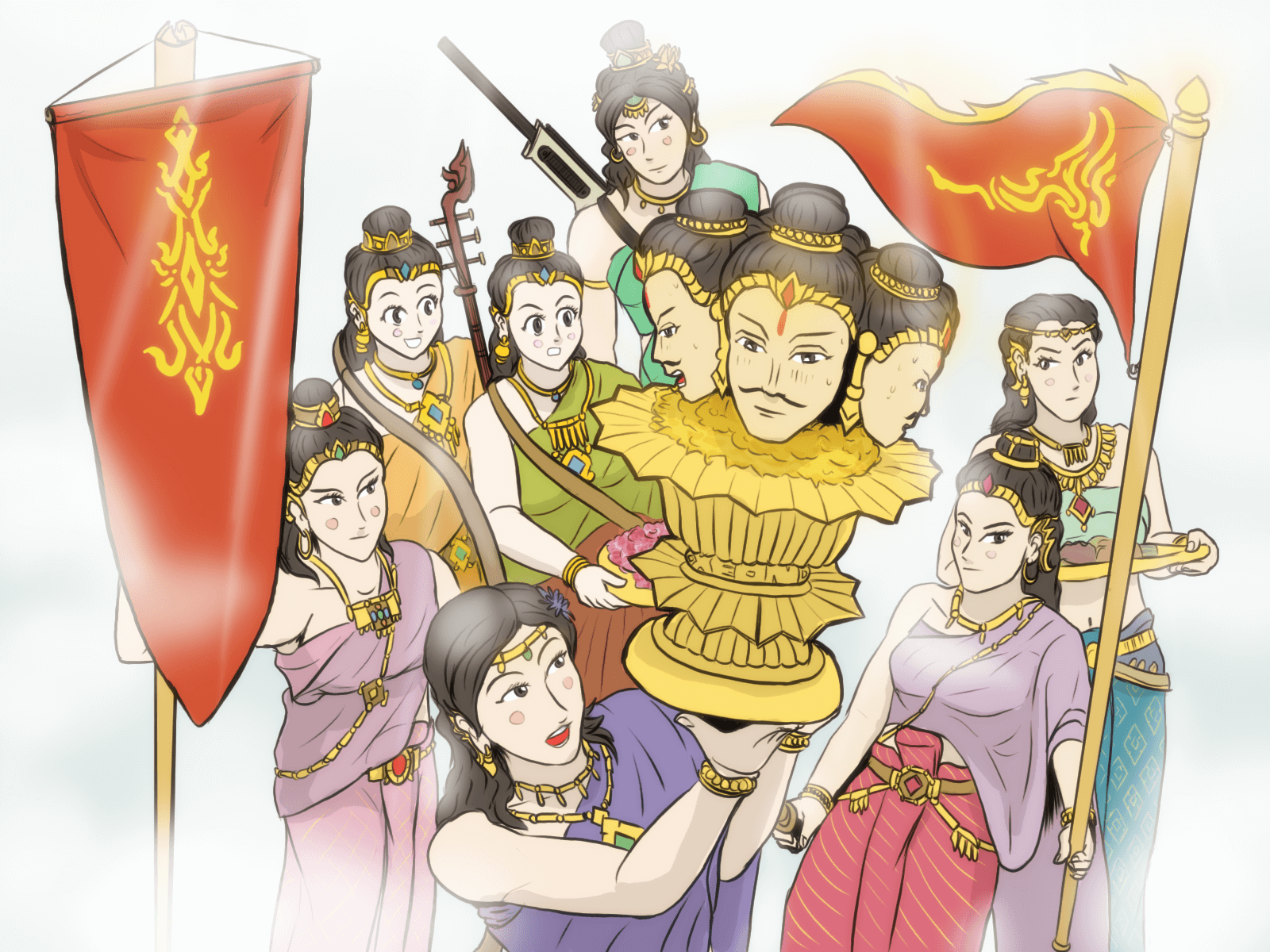
Nang Songkran [cr. VachalenXEON]
In analyzing this tale, we can see that Kabilaphrom’s head symbolizes the sun, heat, and drought of April when Songkran takes place. The water used to clean his head carries the meaning of vitality, fertility, cleanliness, and benevolence. By sprinkling water on each other, we transfer these virtues to our beloved ones, wishing them a fresh and bright new year. The Goddesses of Songkran are the guardians of the earth, safeguarding it from drought, fire, and disasters, and ensuring peace and abundance. Considering the fact that the backbone of Thailand is the agricultural society, the Songkran tradition is integral to the livelihood of Thais and reflects our beliefs deeply rooted in nature.
Activities
The Songkran celebration lasts three days, April 13-15, although some may have started the water fest before that. April 13 is the Songkran day when the sun first enters a new astrological period that marks the beginning of the new year. April 14 is called “Wan Nao” or a work-free day when people put all their tasks aside and focus on purifying their mind. April 15 is the New Year’s Day. In addition, the government has designated April 13 as the Senior Day, and April 14 as the Family Day. As you can see, even though water splashing is the most famous activity of Songkran, play and fun is not the only dimension of this festival.
- Water splashing
If not for the health measures, Bangkok and major cities will organize water splashing events every year. People flock to walking streets like Khao San Road, or those in Pattaya, or Chiang Mai to play with water. The sight will be vibrant with tourists and locals in colorful clothes with flower motifs, colored powder on their cheeks, and joyful cacophony. Highways and main roads are occupied by pick-up trucks carrying water tanks and the Songkran crew with their weapons ready to splash water on whomever ready to engage in the water battle on the road.
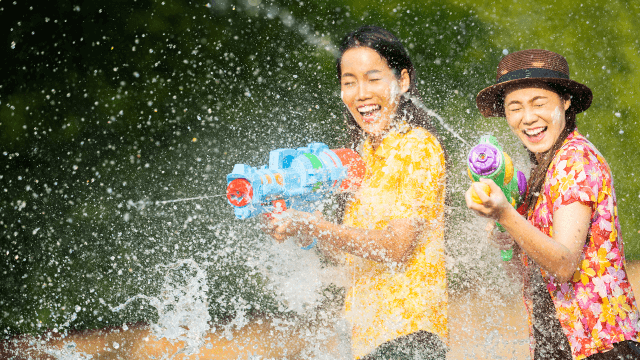
[cr. Thairath]
- Merit making
The majority of Thais practice Buddhism, and in the most important tradition of the year like Songkran, they would not miss an opportunity to add some elements of Buddhism in it. Thais make merit by preparing food to offer to monks on Songkran day either at the temple or at their own home if they invite monks to bless them at their place. Cooking is a labor-intensive activity and a tactic to reunite and mobilize family members.
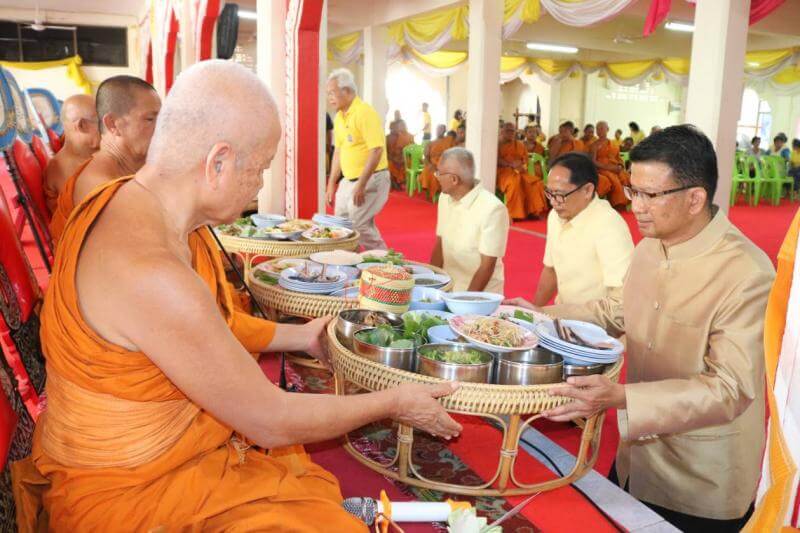
Offering food to monks [cr. Ministry of Culture]
- Sand pagodas
After we finish making merit at the temple and as we walk out the temple’s gate, some grains of sand would get stuck on our shoes. For Thais, that is equal to taking the belongings of the temple away with them, and so we must return them. This is why, during the new year celebration, communities gather to make sand pagodas at the temple as a way to replenish and “return” the temple’s sand. This activity is a clever plan to strengthen the unity of the community.
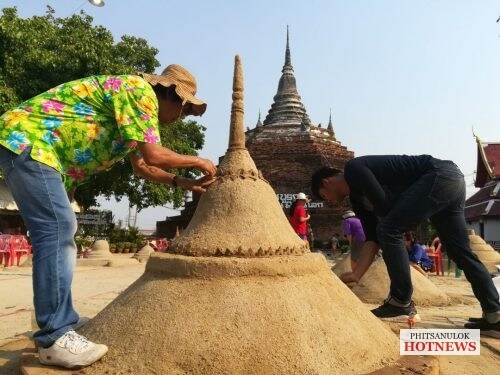 Building sand pagodas [cr. Phitsanulok Hot News]
Building sand pagodas [cr. Phitsanulok Hot News]
- Rod Nam Dam Hua
Another key purpose of Songkran is for younger family members to express gratitude and goodwill to their elder relatives. Rod Nam Dam Hua is a ceremony of Northern Thailand that is now adopted across the country. The ancient meaning of Rod Nam is to bathe while Dam Hua is from the Lanna language and means hair washing. However, we do not literally bathe our senior family members or wash their hair. In Songkran, the Rod Nam Dam Hua ceremony involves pouring scented water onto the hands of the elderly and ask for their forgiveness if we have offended or hurt them in anyway. The elderly will then rub the water on their forehead or head. After that, we offer gifts to the senior relatives who will kindly forgive and bless us. We also bathe the cinerary urns of our ancestors to remember our beloved ones who passed away.
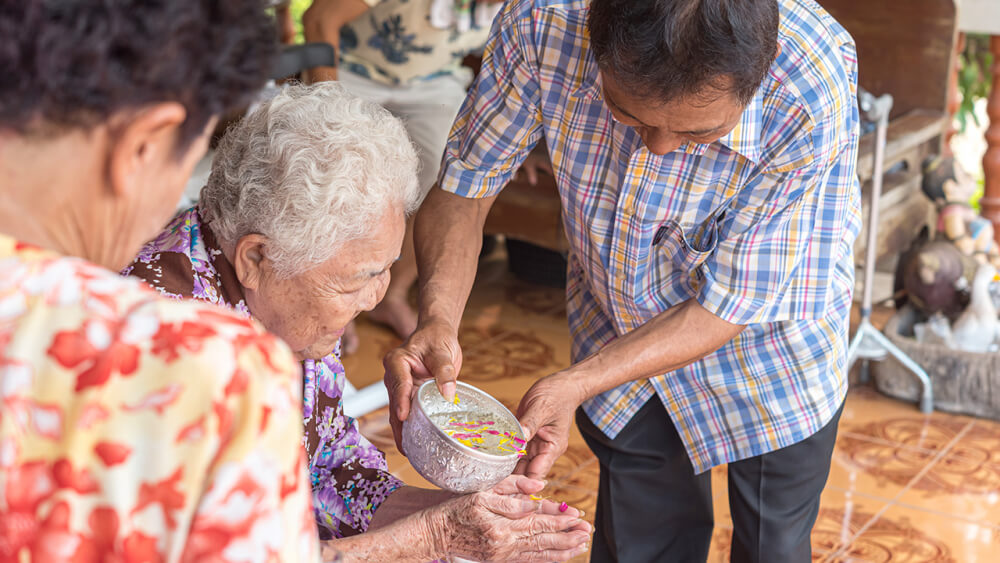 [cr. Thairath]
[cr. Thairath]
- Bathing Buddha images
We bathe Buddha images by sprinkling scented water on them. We can do this in a temple, at certain public places where local administrations organize the bathing ceremony, or at our home. Nowadays, even in places like shopping centers, there are often Buddha images with basins, scented water and small water bowls prepared for visitors. Thai Buddhists believe that bathing Buddha images will bring prosperity to life.
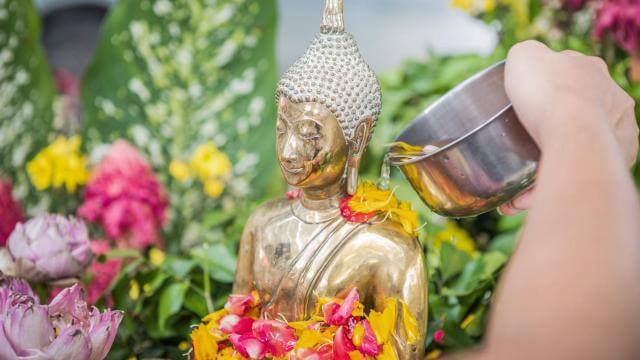
[cr. Thairath]
Regional variations
The activities mentioned above are part of the typical Songkran’s festival, but localized activities are also practiced in different regions of Thailand. In the north, as we build sand pagodas at the temple, we will put paper flags called “Tung” in the pagodas. In the next morning, we will take the Tungs out and use them to support Bodhi trees, a symbolic gesture to preserve Buddhism.
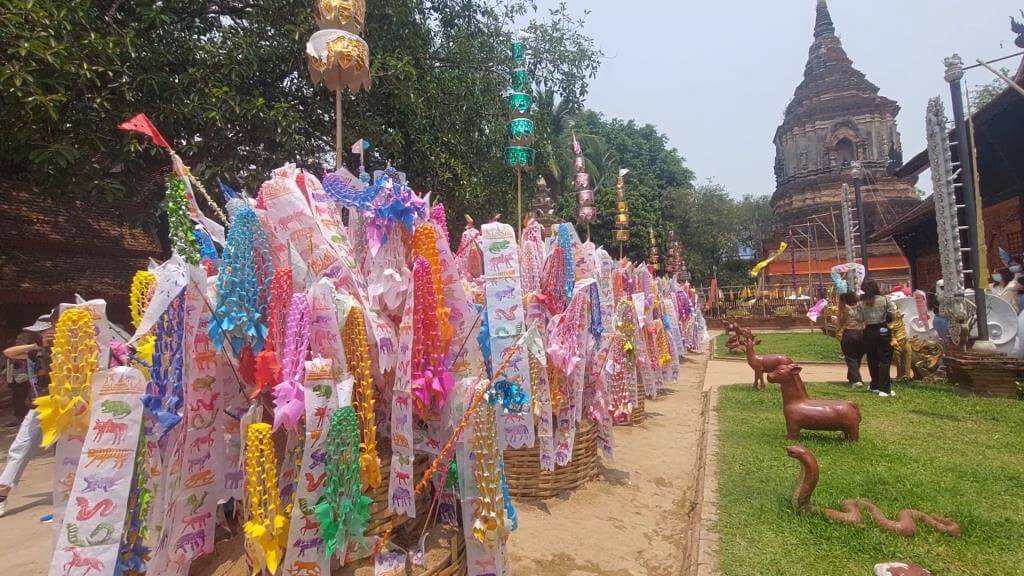
Tungs [cr. Manager Online]
In the northeastern region, people will make a Buddha bathing house, which is a small pavilion to house a Buddha image. Sometimes, they will make a small rail for people to pour water to bathe the Buddha images in the bathing hall.
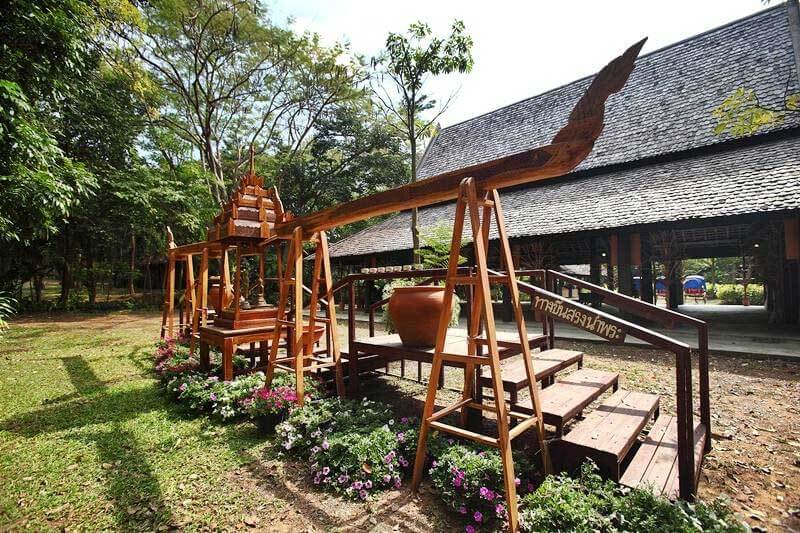
A bathing hall with a rail [cr. Isan Gate]
People in the south take the work-free day very seriously. On this day, all kinds of work are strictly prohibited, whether milling rice, catching fish, cutting hair and nails, chopping trees, climbing trees, killing any kinds of animals, or punishing people or animals. So, hurry up and complete your important tasks before the work-free day arrives.
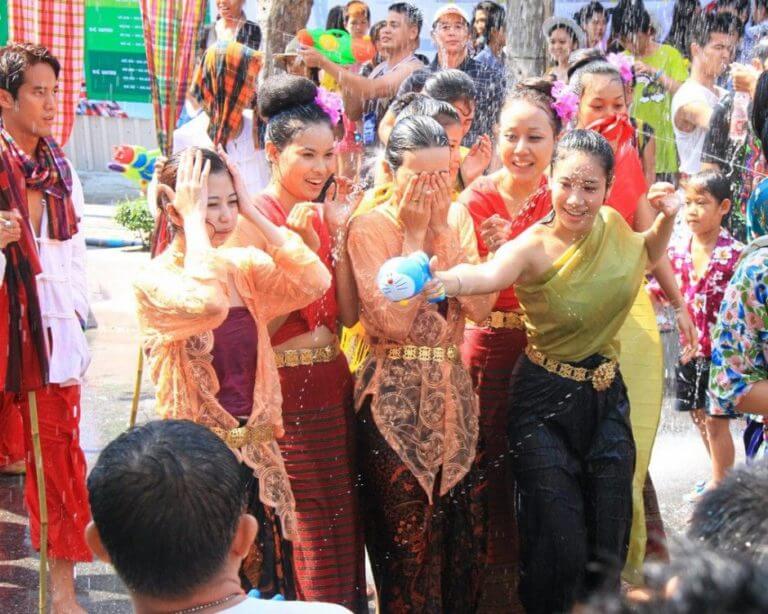 Water splashing in Southern Thailand [cr. Manager Online]
Water splashing in Southern Thailand [cr. Manager Online]
Thais of Mon ancestry living in large communities across Thailand, such as Bangkok, Samut Prakan, and Pathum Thani, will prepare Khao Chae (chilled steamed rice in jasmine water served with condiments) to offer to monks and deities.
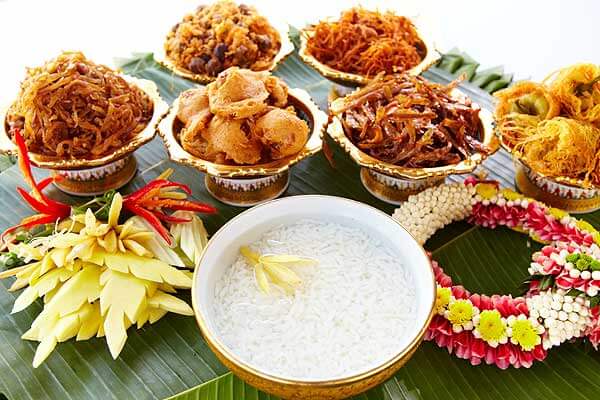
Khao Chae [cr. Ministry of Culture]
Values
- Respect and solidarity
The Songkran holiday is the time for Thais to show respect, gratitude, and forgiveness: the values which are the signature of the Thai people. No matter where they have moved to, if possible, Thais will return to their hometown to visit their elders and perform Rod Nam Dam Hua. Activities on Songkran day that are linked to Buddhism, such as the bathing of Buddha images and construction of sand pagodas, not only purify the mind, but also strengthen solidarity within the community.
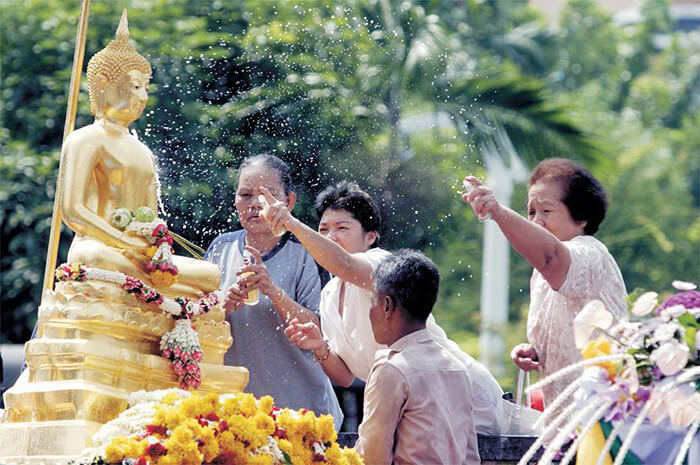
- Cleansing
Songkran symbolizes a new beginning that washes away misfortune, sorrow, and sin. Thais place great importance on cleaning their house because they believe that good fortune can easily enter a clean and neat house. By doing away with old and worn-out objects, we can ready ourselves to welcome fortune and good news in the newly arrived year.
Water is a powerful cleanser. Spiritually, the pure and cool nature of water can calm and purify the mind. Socially, water represents good will and fertility. Thus, splashing water on each other is like giving cool and refreshing blessings.
Connection with other celebrations
Traditions like to Songkran are not exclusive to Thailand. Similar celebrations also exist in other places, especially areas where people practice Theravada Buddhism, such as Laos, Cambodia, Myanmar, Yunnan province of China, Sri Lanka, and India. A shared activity found among many of these celebrations is the splashing of water to bring down the scorching heat of summer. Each of these countries has different names for the celebrations. For example, in Thailand and Laos there is Songkran, in India there is Sangken, in Myanmar there is Thingyan (Burmese New Year), in Cambodia there is Chaul Chnam Thmey (Khmer New Year), in Yunnan, China there is Poshuijie, and many more. The similarities in these celebrations reflect deep cultural and religious connection that bridges different groups of people together.
*******************************
Songkran is a tradition that has been practiced since the ancient time, becoming deeply ingrained into the lives of the Thai people. It is a beautiful festival that delivers a flavorful happiness to everyone, be it the spiritual joy from making merit, the tenderness and hospitality from water gently sprinkled to each other, or the extreme fun from the water fight. It is an opportunity for Thais to tell their loved ones how grateful they are to have each other as family, and to keep the whole community together. The core element of the festival, water, reminds us to cleanse our spirit of grief and other negative thoughts. After all, the origin of Songkran which is associated with nature also tells us not to forget to preserve nature, without which, we will never be able to have a healthier and happier new year.
References
https://www.m-culture.go.th/surin/images/sokkaran.pdf
http://magazine.culture.go.th/2012/1/files/assets/basic-html/index.html#page54
https://en.wikipedia.org/wiki/Water_Festival#:~:text=Southeast%20Asia%5Bedit%5D
Author: Soonyata Mianlamai
Editor: Tayud Mongkolrat
April 15, 2022


